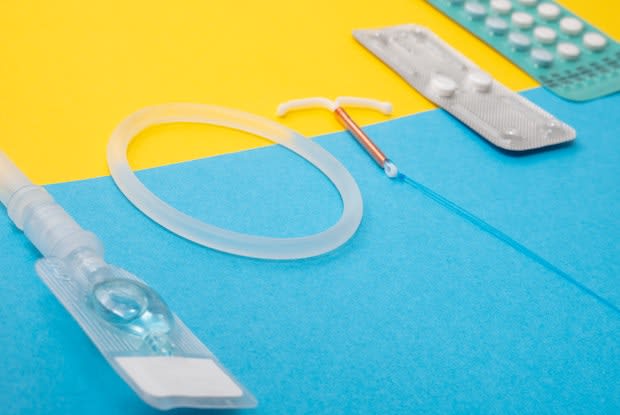Table of Contents
III. Who Can Use Hormone Therapy?
IV. Benefits of Hormone Therapy
What is Menopause?
Many women may look to hormone therapy (HT) as they enter menopause. Hormone replacement therapy uses lab-made versions of hormones to supplement the loss of progesterone and estrogen during menopause. When a woman enters menopause, the ovaries no longer produce estrogen, which leads to the unpleasant symptoms of menopause. These symptoms include:
- Hot flashes
- Vaginal dryness
- Mood changes
- Chills
- Weight gain and slowed metabolism
- Night sweats [1]
Most menopausal medications contain estrogen, progesterone, or a combination of both. These hormones promote bone health and a healthy body system. Women may have been nervous to try hormonal medications in the past because of the increased risk of cancer. Now that more research is available, the benefits and risks of hormone therapy are more well known. Hormonal medications like Premarin, Combipatch, and Provera are now commonly prescribed by doctors. Read on to learn more about the risks and benefits associated with hormone therapy. [2]
Hormone therapy is generally used for menopausal women, but it can be utilized for low hormone levels. For older women, the main goal of menopausal treatment is to replace estrogen. Your treatment depends greatly on whether or not you have had your uterus removed. If no uterus is present, you may be prescribed estrogen alone. This is because estrogen stimulates the growth of uterine lining and should be counterbalanced by progesterone when the uterus is present. Therefore, if you still have your uterus, then you will likely need progesterone. The two most common types of hormone therapy include: Low-dose vaginal products: These types of medications are available in cream, tablet, or ring form. These drugs are applied directly in or around the vagina, minimizing the amount of estrogen absorbed by the body. These low-dose products are typically used if you are experiencing vaginal side effects like dryness and other urinary symptoms. Premarin is one such low-dose vaginal product. Systemic hormone therapy: Systemic therapies come in pill, skin patch, ring, gel, cream, or spray form. These typically have a higher dose of estrogen that is absorbed through the entire body and can treat many common symptoms of menopause. Combipatch is one such system hormone treatment. [2] Your doctor will let you know if hormone therapy is right for you and if the benefits outweigh the risk for your condition. Hormone therapy can be used for: Moderate to severe hot flashes: Hot flashes are the most common symptom for menopausal and perimenopausal women. Hot flashes are feelings of sudden heat and can lead to redness, flushed face, and sweating. Night sweats may occur when you try to sleep as well. Some women never experience them, while others can experience hot flashes for several years. Systemic estrogen works well to combat this bothersome symptom. [3] Early menopause or estrogen deficiency: Women who experience early menopause or have their ovaries removed before 45 years of age may need hormone therapy. Those who have lost normal function of their ovaries before 40 and have primary ovarian insufficiency are also eligible for therapy. Women may experience early menopause if they go through chemotherapy or other surgeries. Estrogen therapy can help reduce younger women’s risk of osteoporosis, heart disease, and mood changes. [2] Bone loss or fracture: When the ovaries stop producing estrogen, it can lead to osteoporosis. Estrogen is integral in bone health, and when it is no longer present, then the bones can become porous and susceptible to fractures. Osteoporosis can lead to thinner bones but can be helped with the addition of systemic estrogen. [2] As described earlier, there are several uses for hormone therapy, and your doctor will prescribe a specific dose for you. There are several benefits to hormone therapy if used correctly, and can significantly improve a woman’s daily life. The following conditions can be improved with hormone therapy: Lower osteoporosis risk: If your doctor feels you are at risk for low bone density, hormone therapy can help protect your bone health. A standard dose of your medication may help prevent broken bones later in life. If you experience early menopause, you may have to take hormones earlier and longer to prevent fractures. Treat an overactive bladder: Perimenopausal and menopausal women may suffer from an overactive bladder. A lack of estrogen can cause the pelvic muscles to weaken and make it more difficult to control your bladder. You may need vaginal estrogen medication to help with this problem and any urinary tract infections. Help prevent diabetes and heart disease: Some studies show that if women use HT within ten years of menopause, their likelihood of heart disease can be reduced. Hormone fluctuations during menopause may disrupt blood sugar levels, which can increase your risk of diabetes. Hormone therapy may help reduce your risk of type 2 diabetes by regulating hormone levels. [4] Vaginal symptom relief: Menopause can significantly affect a woman’s vagina and lead to symptoms that can impact a woman’s sexual life. Hormone therapies can help cure symptoms of vaginal thinning issues, dryness, and painful intercourse. [4] Hormone therapy can pose risks for some women, especially if they have a personal or family history of certain conditions. Risks of hormone therapy can include: Breast cancer: New research has found that women can take estrogen therapy for menopausal symptoms up to seven years before their risk for breast cancer increases. The risk may be lower if they intermittently use progesterone and use hormone therapy early. [4] Uterine cancer: Women who have not had a hysterectomy are at risk for uterine cancer if they use estrogen therapy alone. If you have already had uterine cancer, your doctor may advise against estrogen hormone therapy and recommend progesterone by itself. Blood clots: If you take oral HT medications, you are at a higher risk for blood clots. Estrogen increases plasma concentrations in the blood as well as clotting factors, leading to a risk of blood clots. You can lower your risk for blood clots by using transdermal estrogen, like a patch, gel, or spray. Stroke: Those who take estrogen and estrogen/progesterone therapy can increase the risk of stroke. This risk is compounded if a woman is already experiencing conditions like high blood pressure or heart disease. [4] The content in this article is intended for informational purposes only. This website does not provide medical advice. In all circumstances, you should always seek the advice of your physician and/or other qualified health professionals(s) for drug, medical condition, or treatment advice. The content provided on this website is not a substitute for professional medical advice, diagnosis or treatment.
Types of Hormone Therapy
Who Can Use Hormone Therapy?

Benefits of Hormone Therapy

Risks of Hormone Therapy
